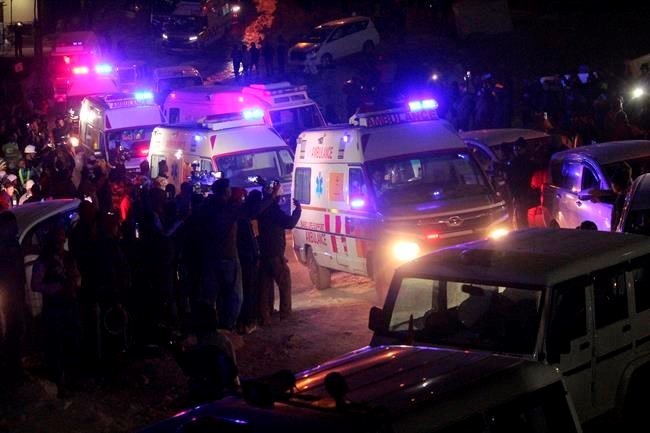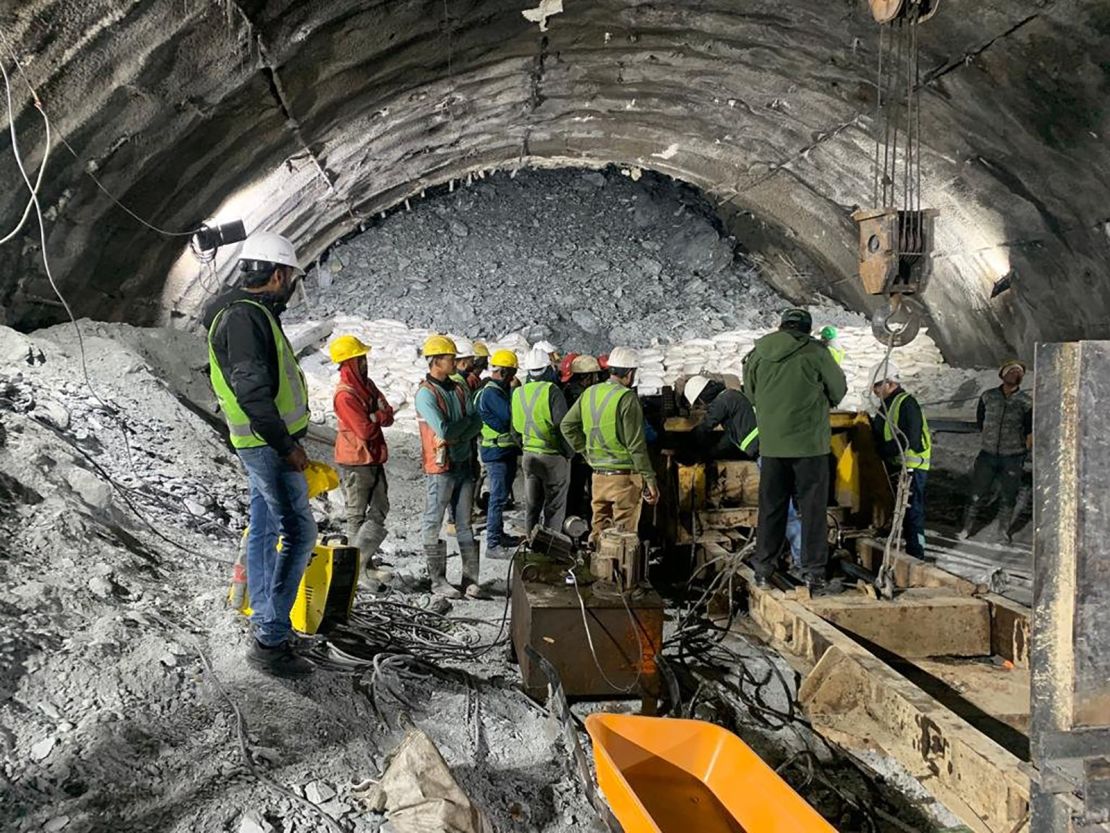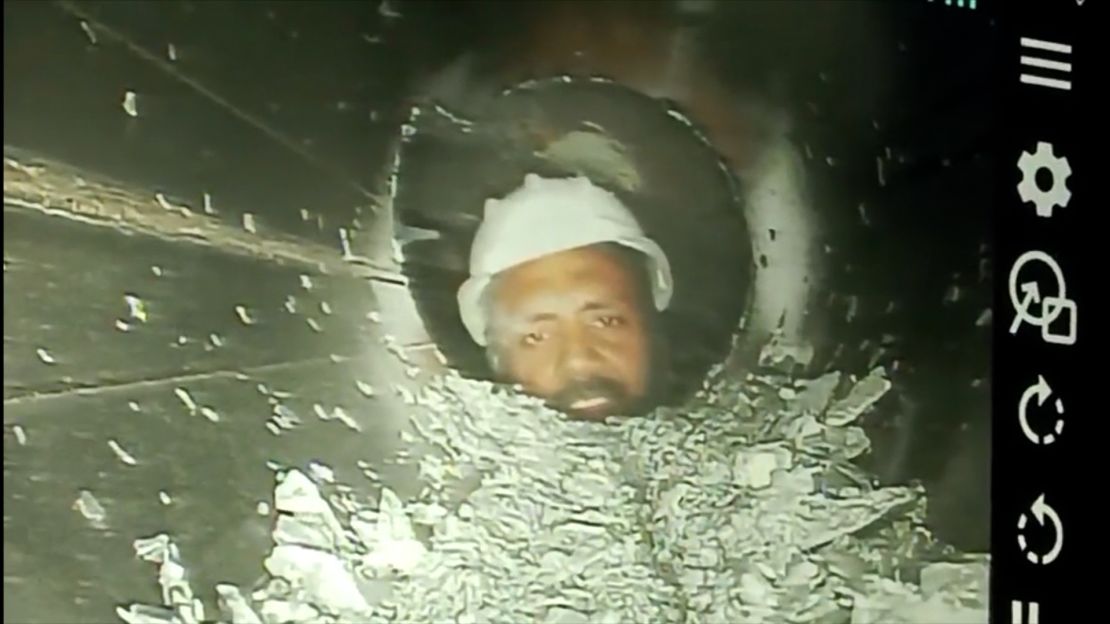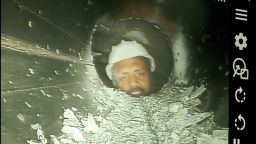SILKYARA, India - When heavy machinery broke down trying to break through the debris trapping 41 workers in a tunnel in the Indian Himalayas, authorities called in a group of people whose profession is effectively banned in the country - "rat-hole mining".
While augur machines managed to horizontally drill through nearly three-quarters of the debris, it fell on half a dozen miners adept at burrowing in tight spaces to reach the trapped workers on Nov 28.
Rescuers successfully pulled out the workers in wheeled stretchers through a wide pipe that was pushed through the debris after a 17-day ordeal.
"It was a difficult task, but for us nothing is difficult," said a beaming Mr Firoz Qureshi, one of the miners, standing with his fellow workers outside the tunnel, their faces patched with white dust after overnight drilling.
The "rat miners" started working late on Monday after a second drilling machine also broke down with 15m out of 60m still left to reach the trapped men.
They worked in two teams of three each, with one person drilling, the second collecting the debris and the third pushing it out of the pipe.
They said they had worked for more than 24 hours.
"When we saw them inside the tunnel after the breakthrough, we hugged them like they were family," said Mr Nasir Hussain, one of the six miners.
"Rat-hole" mining is a hazardous and controversial method used extensively in the northeastern state of Meghalaya to extract thin seams of coal before an environmental court in 2014 banned the practice because of environmental damage and many fatalities.
Some of the miners involved in the rescue operation said they were not involved in coal mining and got their training in Delhi.
The name comes from its resemblance to rats burrowing pits into the ground. The pits are sized just enough for the workers, often children, to descend using ropes or ladders to extract coal - often without safety measures and proper ventilation.
At least 15 miners were killed in one such "rat hole" mine in Meghalaya after being trapped for more than a month until January 2019 - one of the many tragedies in the state where rights group say 10,000 to 15,000 have died in such mines between 2007 and 2014.
The practice became illegal in the 1970s, when India nationalised coal mines and gave state-run Coal India a monopoly.
Still, many small mine owners continued to employ short people or children to illegally extract coal and the federal government did not interfere, given the state's remote location and the low quality of its coal.
Indian rescuers pull out all 41 workers who were trapped in a tunnel for 17 days, minister says

UTTARKASHI, India (AP) — All 41 construction workers who were trapped in a collapsed mountain tunnel in northern India for more than two weeks were pulled out on Tuesday, bringing an end to a drawn-out rescue mission that had grabbed the country's attention for days.
A crowd of local residents gathered around the tunnel erupted in joy and shouted slogans of “Bharat Mata ki Jai”, or “Long live mother India,” and set off firecrackers in celebration. Officials presented the first rescued workers with garlands made of flowers, hanging them around their necks as the crowd cheered.
Nitin Gadkari, the minister of road transport and highways, said on X, formerly known as Twitter, that he was “completely relieved and happy” after all workers were rescued from the Silkyara Tunnel in Uttarkashi following an ordeal that lasted 17 days.
“I am very happy that all the 41 trapped workers have come out and their lives have been saved,” he said in a video message posted on X. Gadkari added that “this was a well-coordinated effort by multiple agencies, marking one of the most significant rescue operations in recent years.”
The workers were pulled out through a passageway made of welded pipes that rescuers previously pushed through dirt and rocks. They will each have an initial health checkup at a temporary medical camp set up inside the 13-meter (42.6 feet) wide tunnel.
One of the rescuers, Devender, who only gave his first name, told the New Delhi Television channel that “the trapped workers were overjoyed when they spotted us in the tunnel. Some rushed toward me and hugged me.”
The massive rescue mission had many on edge. The workers got trapped on Nov. 12, when a landslide caused a portion of the 4.5-kilometer (2.8-mile) tunnel they were building in Uttarakhand state to collapse about 200 meters (650 feet) from the entrance.
They survived on food and oxygen supplied through narrow steel pipes.
Kirti Panwar, a state government spokesperson, said about a dozen men had worked overnight to manually dig through rocks and debris, taking turns to drill using hand-held drilling tools and clearing out the muck in what he said was the final stretch of the rescue operation.
Rescuers resorted to manual digging after the drilling machine broke down on Friday while drilling horizontally from the front because of the mountainous terrain of Uttarakhand. The machine bored through about 47 meters (nearly 154 feet) out of approximately the 57-60 meters (nearly 187-196 feet) needed, before rescuers started to work by hand to create a passageway to evacuate the trapped workers.
By Tuesday, they had drilled through more than 58 meters (190 feet). As dusk fell, families of those trapped underground gathered near the site of the accident, anxiously waiting to see their loved ones emerge from the tunnel.
Among them was Jaimal Singh who said he was hopeful he would soon see his brother Gabbar Singh, who is trapped inside. “Even nature looks cheerful today ... the weather is good. Let’s hope this ends soon,” he told the Press Trust of India news agency.
Rescue teams had inserted pipes into dug-out areas and welded them together so the workers could be brought out on wheeled stretchers. On Sunday, rescuers also began to create a vertical channel with a newly replaced drilling machine as a contingency plan.
What began as a rescue mission expected to take a few days has turned into weeks, and officials have been hesitant to give a timeline for when it might be completed.
“I just feel good. The drilling on top of the mountain is coming along perfectly, in the tunnel, it’s coming along very well. I have never said ‘I feel good’ before,” Arnold Dix, an international tunneling expert who is helping with the rescue, told reporters at the site earlier on Tuesday.
Most of the trapped workers are migrant laborers from across the country. Many of their families have traveled to the location, where they have camped out for days to get updates on the rescue effort and in hopes of seeing their relatives soon.
As the operation unfolded, the trapped workers were supplied with hot meals through a 6-inch (15-centimeter) pipe after days of surviving only on dry food sent through a narrower pipe. They were getting oxygen through a separate pipe, and more than a dozen doctors, including psychiatrists, were at the site, monitoring their health.
The tunnel the workers were building was designed as part of the Chardham all-weather road, which will connect various Hindu pilgrimage sites. Some experts say the project, a flagship initiative of the federal government, will exacerbate fragile conditions in the upper Himalayas, where several towns are built atop landslide debris.
Large numbers of pilgrims and tourists visit Uttarakhand’s many Hindu temples, with the number increasing over the years because of the continued construction of buildings and roadways.
The Associated Press
The 41 construction workers have been trapped since November 12 in a tunnel being constructed between the remote towns of Silkyara and Dandalgaon in the Himalayan state of Uttarakhand.

A drilling machine was brought up to a forested hill above the tunnel on a specially constructed track. / Photo: AFP
Indian rescue teams digging by hand are now within five metres of 41 men who have been trapped in a collapsed road tunnel for over two weeks, officials said Tuesday, saying a breakthrough was expected "soon."
After repeated setbacks in the operation, military engineers and skilled miners are working by hand in a painstaking dig through rock and rubble towards the men using a so-called "rat-hole" mining technique to clear the final stretch.
Some five metres (16 feet) of rubble remain, chief minister of Uttarakhand state Pushkar Singh Dhami told reporters at the site as rescue efforts entered their 17th day.
"The escape passage has been prepared up to 52 metres inside the tunnel, and the passage will break through at 57 metres," Dhami said Tuesday morning.
"The rescue operation is expected to be completed soon," he added, without giving a specific timeframe, raising hopes the end was in sight for the marathon operation.
However, previous hopes of reaching the men have been dashed by falling debris and the breakdown of multiple drilling machines.
The government has repeatedly warned that timelines are subject to "technical glitches, the challenging Himalayan terrain, and unforeseen emergencies".
The 41 construction workers have been trapped since November 12 in a tunnel being constructed between the remote towns of Silkyara and Dandalgaon in the Himalayan state of Uttarakhand.
'Last hope'
Rajput Rai, a drilling expert, told the Press Trust of India that three-person teams were taking turns working at the rock face inside a metal pipe, just wide enough for someone to squeeze through.
While one worker drills, a second scoops up the rubble by hand, and the third places it on a wheeled trolley to be pulled out, Rai said, according to PTI's Tuesday report.
Rescuers have brought in a superheated plasma cutter to slice through metal rods that have repeatedly impeded progress.
Tunnel expert Chris Cooper, who is advising the rescue teams said Monday that progress depended on "how the ground behaves", warning they may yet have to cut through heavy-duty girders that had been meant to hold the collapsed roof up.
Last week, engineers working to drive a metal pipe horizontally through the 57 metres of rock and concrete ran into metal girders and construction vehicles buried in the rubble, snapping a giant earth-boring machine.
In a separate effort, a drilling machine was brought up to a forested hill above the tunnel on a specially constructed track.
Vertical drilling from that location is now nearly halfway through the 89 metres needed to reach the stranded men, a risky route in an area that has already suffered a collapse.
Digging, blasting and drilling have also begun from the far side of the road tunnel, a much longer third route estimated to be around 480 metres.
The workers were seen alive for the first time on Tuesday, peering into the lens of an endoscopic camera sent by rescuers down a thin pipe through which air, food, water and electricity are being delivered.

'Rat-hole mining': India digs by hand to free 41 trapped tunnel workers

India initiates vertical drilling operation to save tunnel-trapped workers

India rescuers hit snags in two-week bid to free 41 tunnel workers
By AFP
November 28, 2023

The Silkyara road tunnel in northern India, which partially collapsed on November 12
Pitcha DANGPRASITH
Indian rescue teams crept forward Tuesday in a painstaking dig by hand through rock and rubble towards 41 workers who have been trapped in a collapsed road tunnel for 17 days.
Soldiers and skilled miners are using a so-called “rat-hole” mining technique to clear the final stretch, digging through some two metres (six feet) of rubble to leave only an estimated seven metres (23 feet) to go.
Rajput Rai, a drilling expert, told the Press Trust of India that three-person teams are taking turns working at the rock face inside a metal pipe, just wide enough for someone to squeeze through.
While one worker drills, a second scoops up the rubble by hand, and the third places it on a wheeled trolley to be pulled out, Rai said, according to PTI’s Tuesday report.
Rescuers have brought in a superheated plasma cutter to slice through submerged metal rods that have repeatedly impeded progress.
Tunnel expert Chris Cooper, who is advising the rescue teams, said Monday he was optimistic that they would break through.
“It depends on how the ground behaves,” he told reporters, adding that they may have to cut through heavy-duty girders that had been meant to hold the collapsed roof up.
“We are confident that we can overcome it.”
The 41 construction workers have been trapped since November 12 in a tunnel being constructed between the remote towns of Silkyara and Dandalgaon in the Himalayan state of Uttarakhand.
The more than two-week-long rescue operation has been hit by repeated setbacks.
– ‘Last hope’ –
Efforts have been complicated by falling debris and repeated breakdowns of drilling machines.
Last week, engineers working to drive a metal pipe horizontally through 57 metres (187 feet) of rock and concrete ran into metal girders and construction vehicles buried in the rubble, snapping a giant earth-boring auger machine.
In a separate effort, a drilling machine was brought up to a forested hill above the tunnel on a specially constructed track.
Vertical drilling from that location is now nearly halfway through the 89 metres (292 feet) needed to reach the stranded men, a risky route in an area that has already suffered a collapse.
Digging, blasting and drilling have also begun from the far side of the road tunnel, a much longer third route estimated to be around 480 metres (1,575 feet).
The workers were seen alive for the first time on Tuesday, peering into the lens of an endoscopic camera sent by rescuers down a thin pipe through which air, food, water and electricity are being delivered.
“Our only source of strength is God, as it is the last hope for us,” said mother-of-three Musarrat Jahan, whose husband Mohd Sabah Ahmad is a migrant worker trapped inside.
“We have more faith in God than anything”, she told AFP by phone from her home in the eastern state of Bihar, one of India’s poorest.
Though trapped, the workers have plenty of space in the tunnel, with the area inside 8.5 metres (28 feet) high and stretching about two kilometres in length.
Rescuers begin risky vertical drilling after agonizing bid to free trapped Himalayan tunnel workers falters
By Rhea Mogul and Aishwarya Iyer, CNN
Mon November 27, 2023
New DelhiCNN —
The weekslong effort to save 41 workers trapped in a collapsed Himalayan tunnel has entered a perilous new phase, with rescuers attempting to drill downward through unstable mountain terrain after a safer route faltered at the final stage.
The men have been trapped since November 12 when the part of tunnel they were helping to construct in India’s northern Uttarakhand state gave way, blocking their only exit with more than 60 meters (200 feet) of broken rock, concrete and twisted metal.
Engineers had previously attempted to excavate the debris in the exit shaft but were forced to abandon efforts late on Friday after the powerful US-made drill they were using broke down just meters from the trapped men.
The setback was the latest to befall the complex and challenging operation, that has twice seen officials suggest a rescue was imminent only for conditions to change and efforts halt.
Authorities are now attempting to manually dig through the remaining debris in the exit tunnel while simultaneously drilling down from a forested hill some 86 meters (282 feet) above the trapped men.

India airlifted a high-powered drilling machine to assist in the rescue of dozens of road workers trapped underground.AshokKumar_IPS/X
The vertical drilling had reached a depth of 35 meters (114 feet) by Monday, according to the secretary of India’s Ministry of Road Transport Highways, Mahmood Ahmed, who estimated work could be completed by Thursday.
But geologists have warned vertical drilling is fraught with risk and warned it could weaken the fragile mountain, causing more debris to fall into the already partially collapsed tunnel chamber.
“The rock types in the Himalayas are very weak,” Yaspal Sundriyal, a geology professor from the H.B. Garhwal University in Uttarakhand told CNN.
“The vertical drilling will disturb the rock formation and will cause vibrations to the mountain,” said Sundriyal, who is considered an expert in local rock formations.
“The rocks in the Himalayas should be treated very cautiously and with very strong support. I’m afraid drilling will disturb the soil of the rock above the tunnel.”
On site, authorities say both rescue options are considered safe options, but are unable to tell which will deem most effective.
“Both vertical and horizontal drilling are safe,” said Harpal Singh, the former director of India’s Border Roads Organization that maintains the country’s road networks.
“However, it is difficult to say which one of the two methods would help us reach the trapped workers first,” he told reporters Monday.
Families face agonizing wait
The trapped men, all migrant workers from some of India’s poorest states, have been receiving food, water and oxygen through a 53-meter (173 foot) pipe that has been inserted through the debris and authorities say they remain in good health.
Doctors on site have kept in regular contact with the men inside, giving them tips on how to remain positive and calm.
But for most of the families of the trapped men, the wait has been an agonizing switch between hope and despair.

One of the trapped workers can be seen on camera.Uttarakhand Government Handout
Mahi Shah, whose brother-in-law Sonu is trapped inside, said his family didn’t learn about the incident until his grandfather read about the collapse in the newspaper on November 14.
Shah immediately took a train from his home in India’s eastern Bihar state to be closer to Sonu, he said.
Like other relatives, Shah has gathered at the tunnel exit each day to pray beside a makeshift temple.
“The fear inside Sonu’s mind is growing bigger and bigger,” Shah said, adding that he has a seven-year-old daughter who keeps asking where her father is.
”We have not told her the truth yet. We hope we don’t need to… Everyone at home is petrified.”
Krishna Chauhan, whose 21-year-old nephew Manjeet is stuck inside, said the wait is a reminder of another heartbreaking incident their family had to endure nearly two years ago.
Manjeet’s older brother, also a construction worker, was killed after he suffered an electric shock while working in Mumbai. The family is still coping with that loss, Chauhan said, adding Manjeet is the one that holds them together.
They are holding onto hope that Manjeet will walk out of the tunnel safely.
“Manjeet is known to be the one to make everyone laugh in the house,” Chauhan said.
“Right now, the priority is (the men) come out. No project should be allowed without any safety inside. We want an investigation”
‘Coming home by Christmas’
The tunnel is part of Indian Prime Minister Narendra Modi’s Char Dham Highway route, a controversial multimillion dollar project to upgrade the country’s transport network and improve connectivity to important Hindu pilgrimage sites in the region.
The project has received criticism from environmentalists who say the heavy construction could seriously damage the Himalayan region, where millions are already feeling the impact of the climate crisis.

New video shows trapped laborers alive in Himalayan tunnel but rescue still no closer
A panel of experts told India’s Supreme Court that construction of the highways will “lead to further landslides and soil erosion in an already sensitive environment,” according to a 2020 report by the court.
Authorities are investigating the cause of the tunnel collapse and are likely to examine the role of drilling on the mountain. CNN has contacted the Ministry of Environment, Forest and Climate Change of India.
On Friday, tunneling expert Anrold Dix, an Australian engineer who has flown to India to consult on the rescue effort said they were putting the safety at the core of the operation.
“With each option, we are considering how do we make sure that 41 men come home safe and we don’t hurt anyone,” Dix told reporters.
“I am confident that the 41 men are coming home by Christmas… If we rush, we can cause another problem in there.”
No comments:
Post a Comment